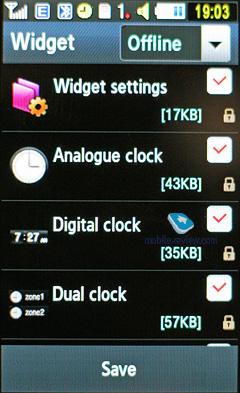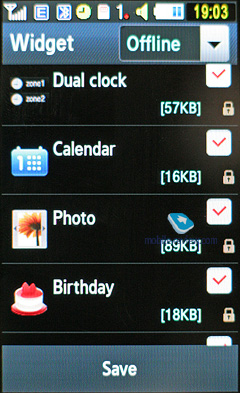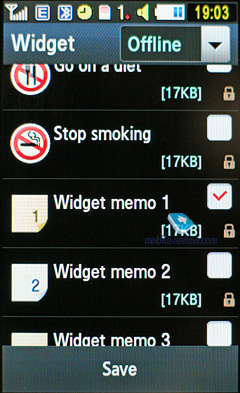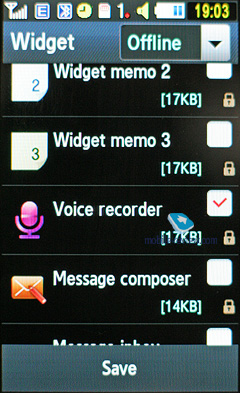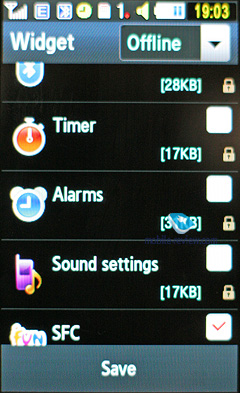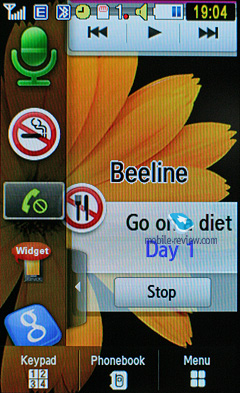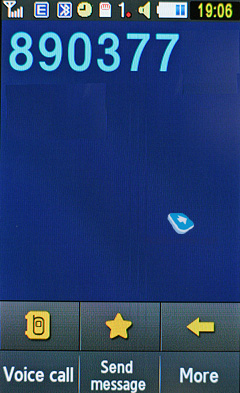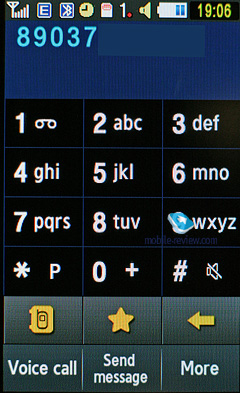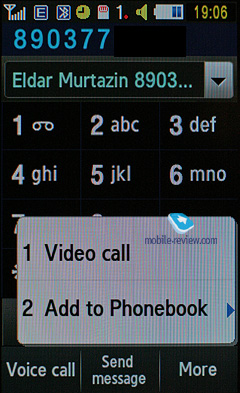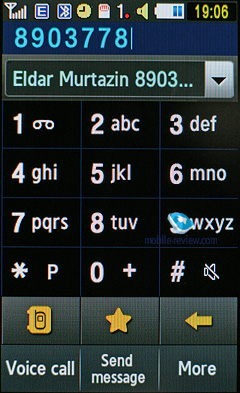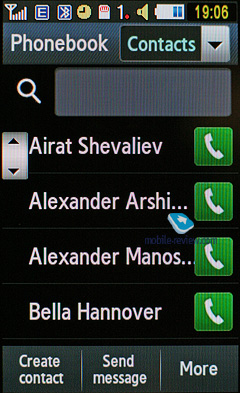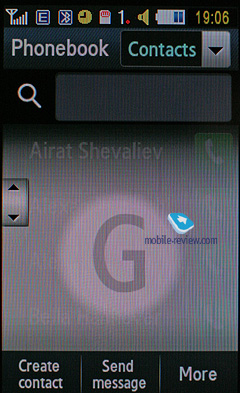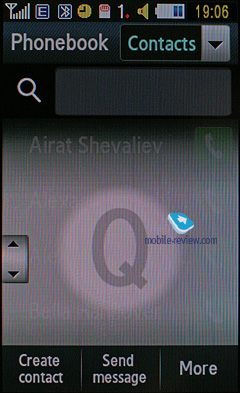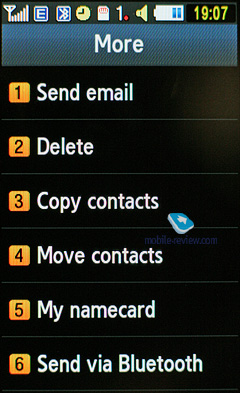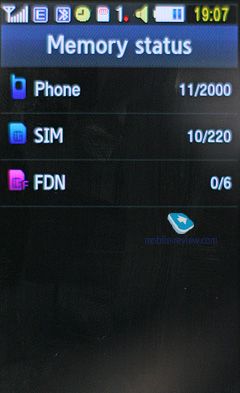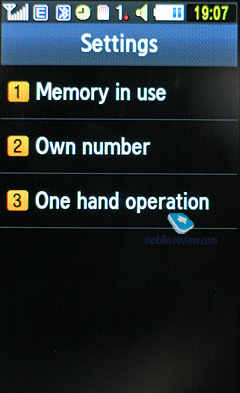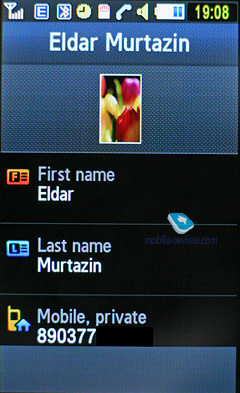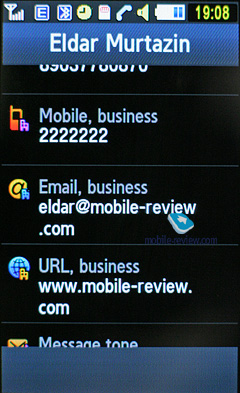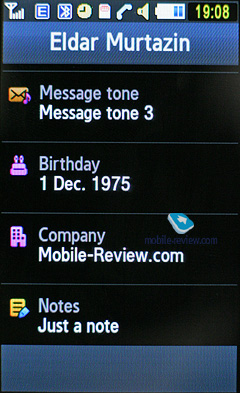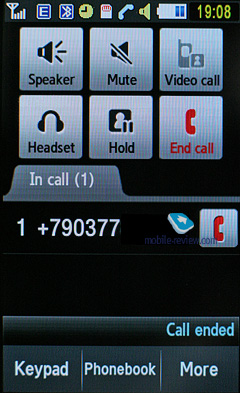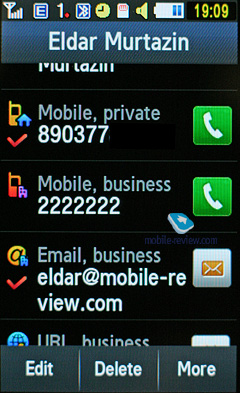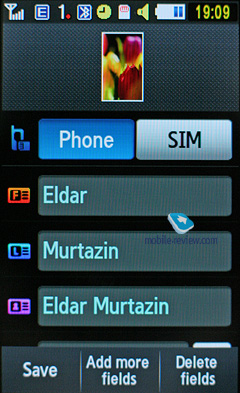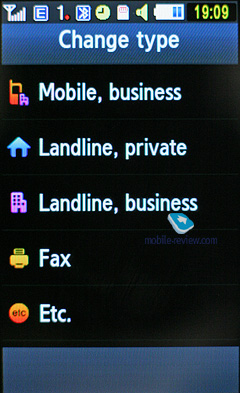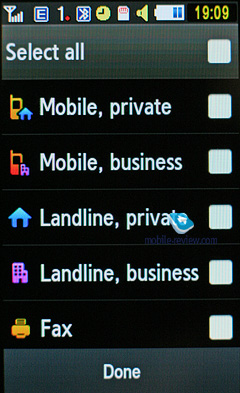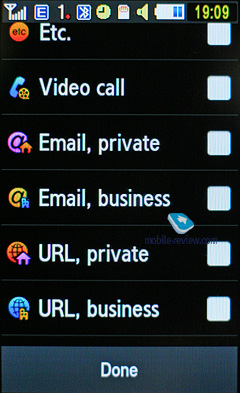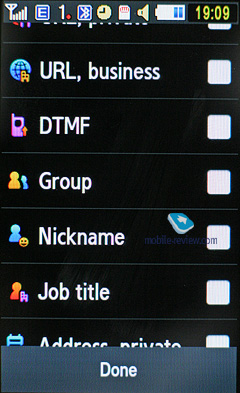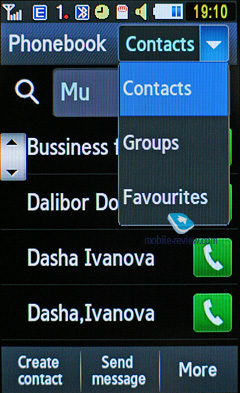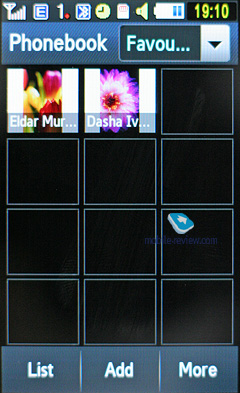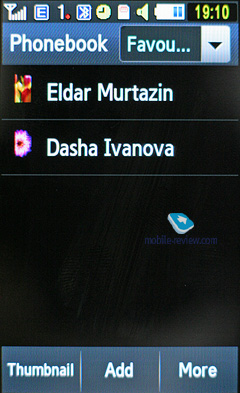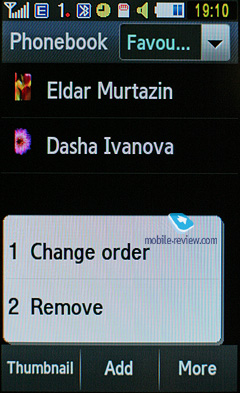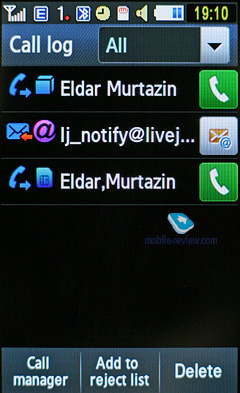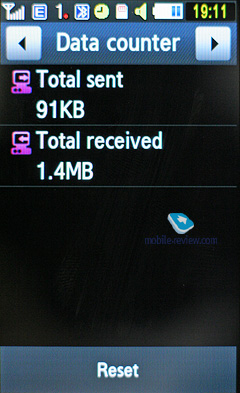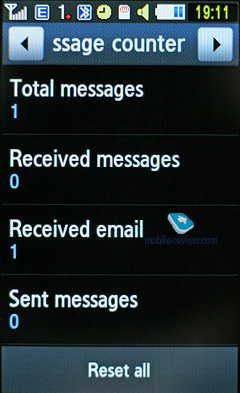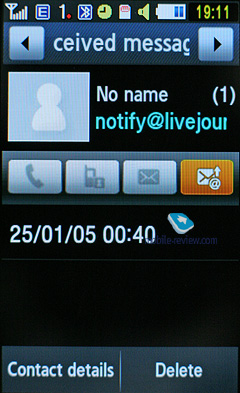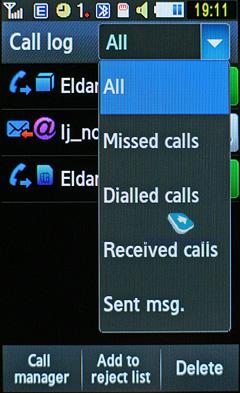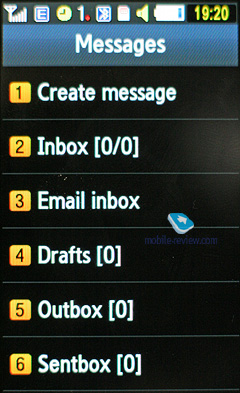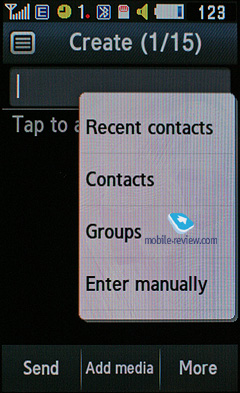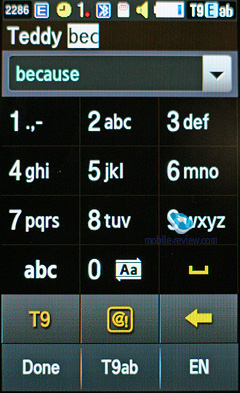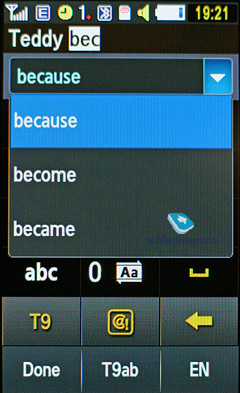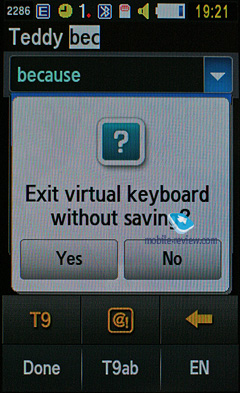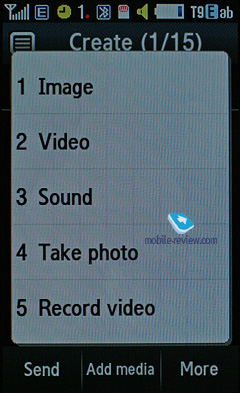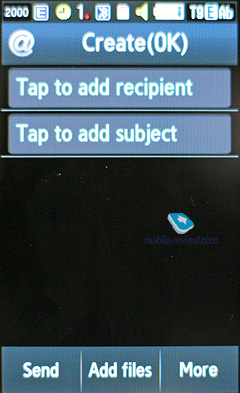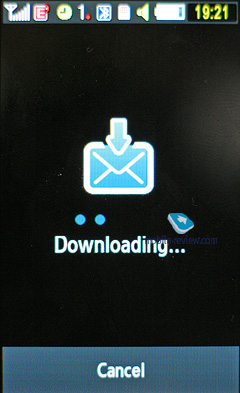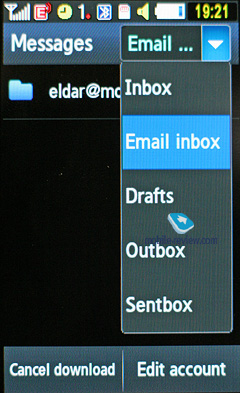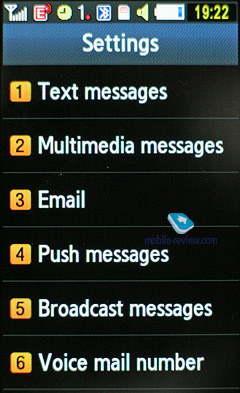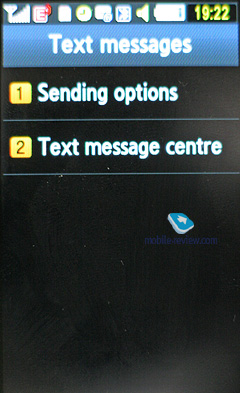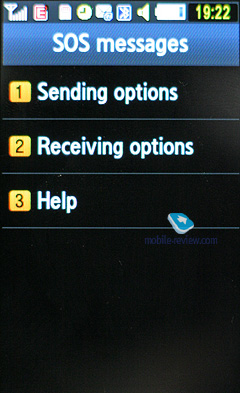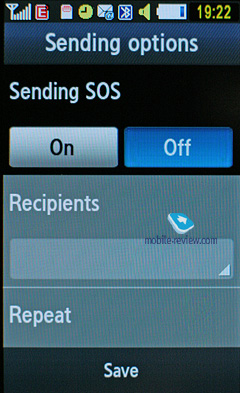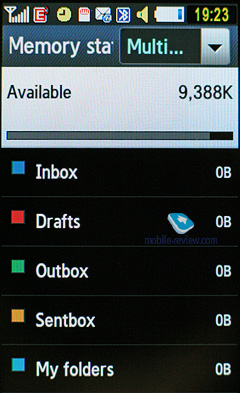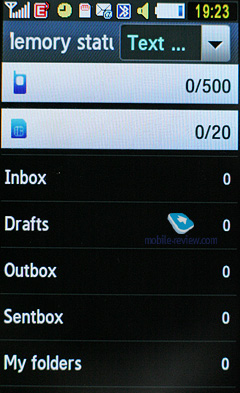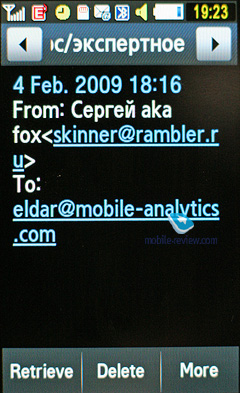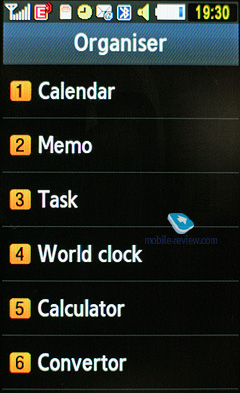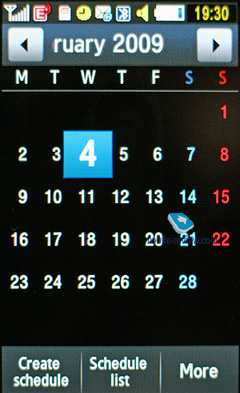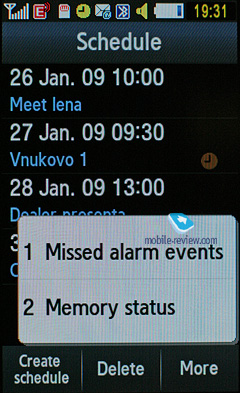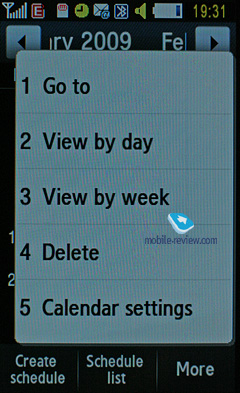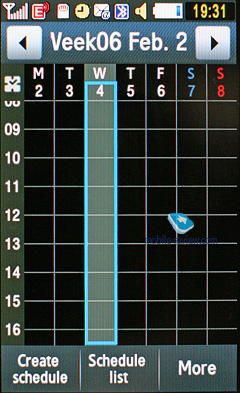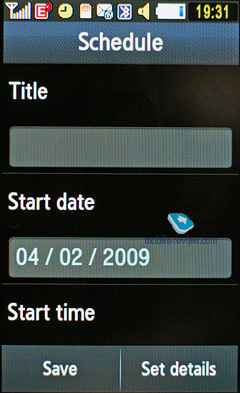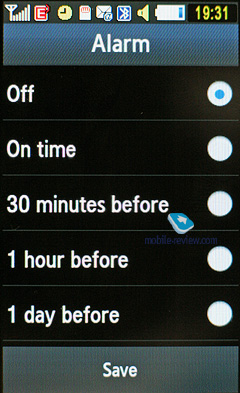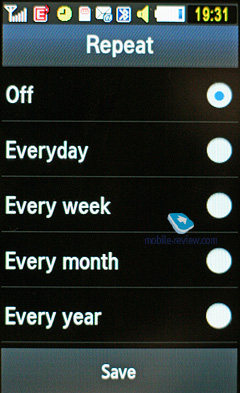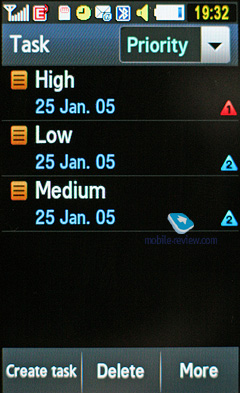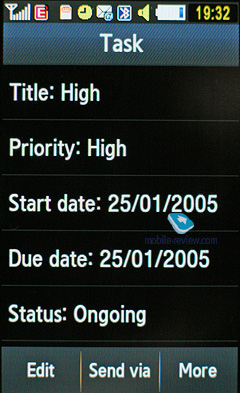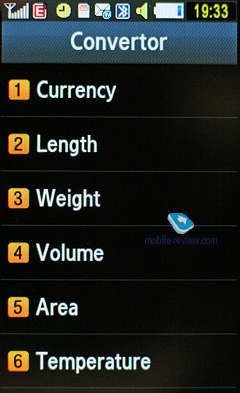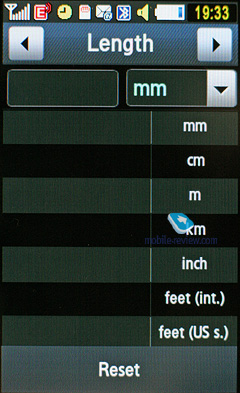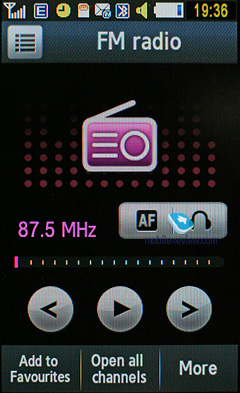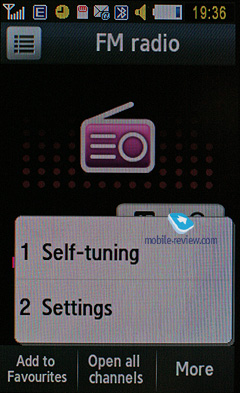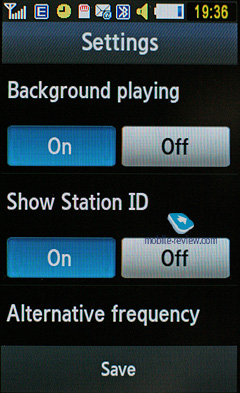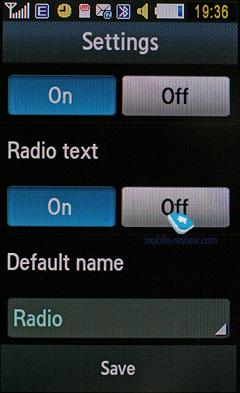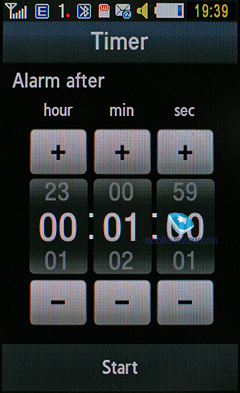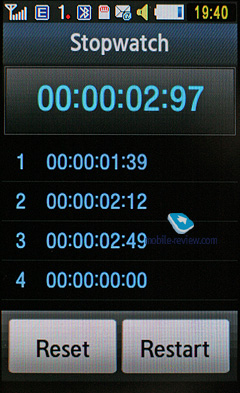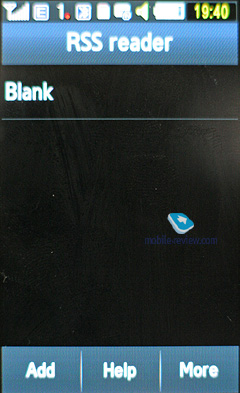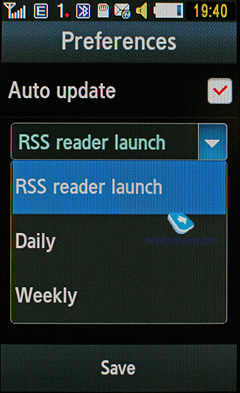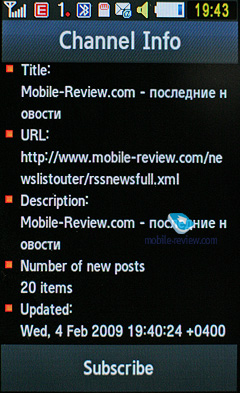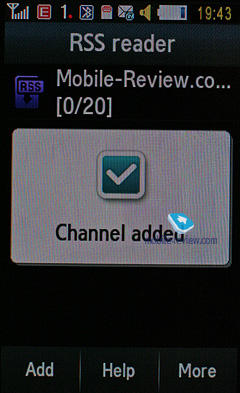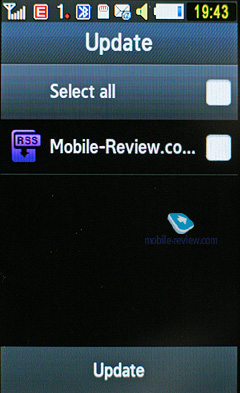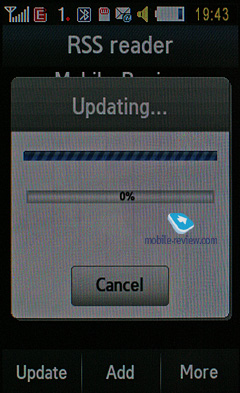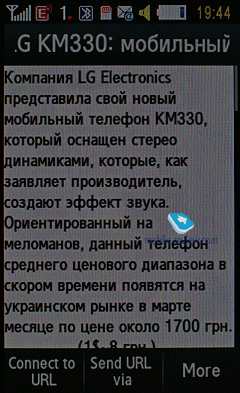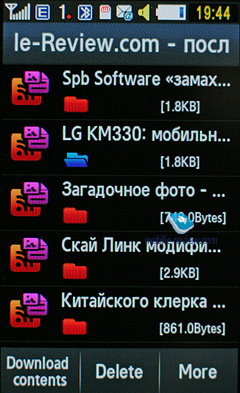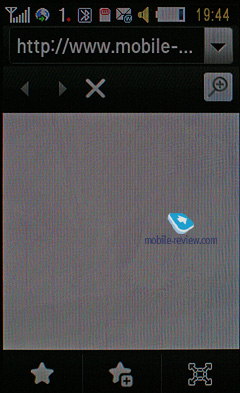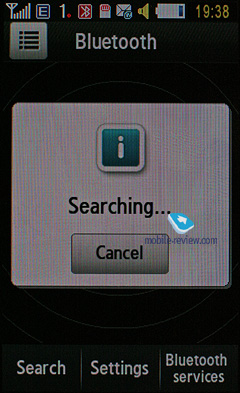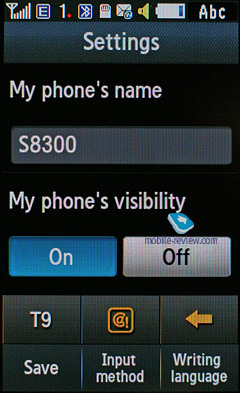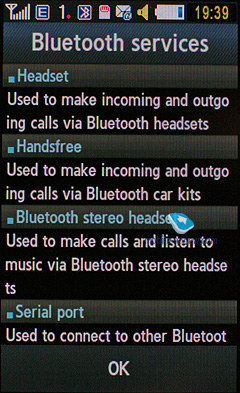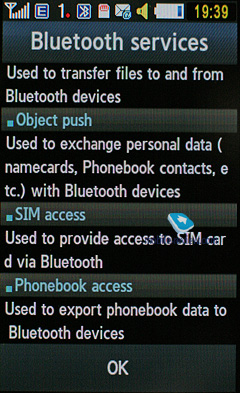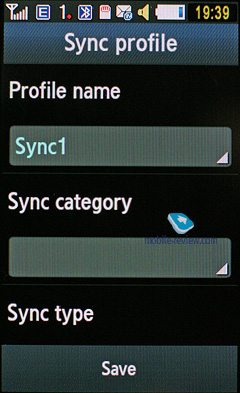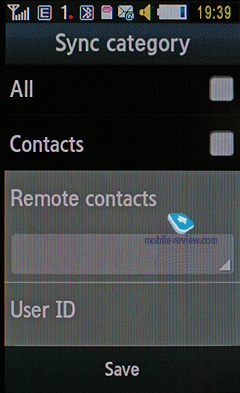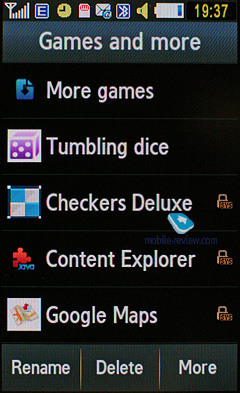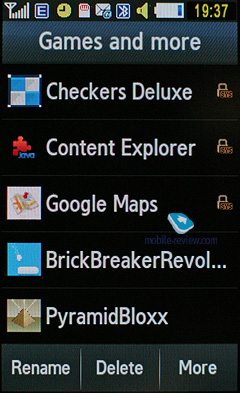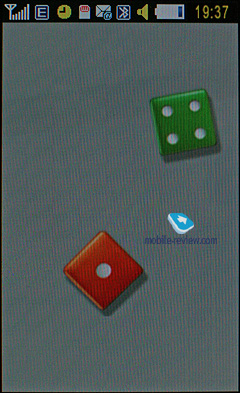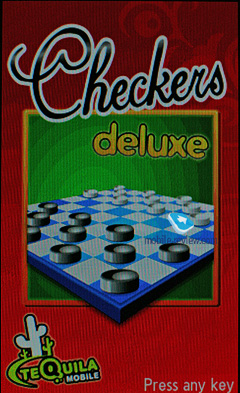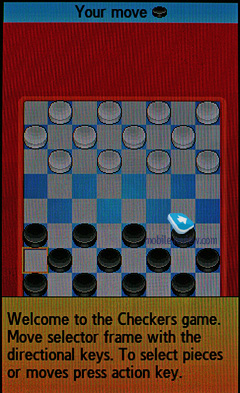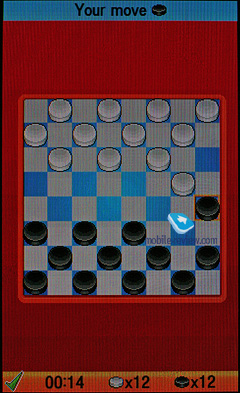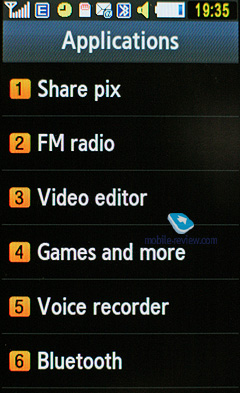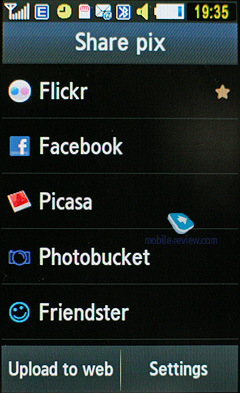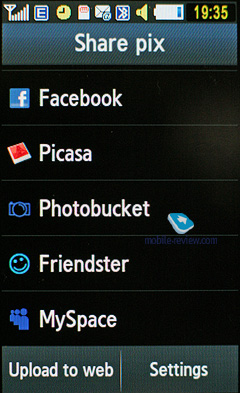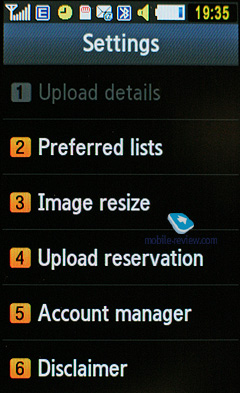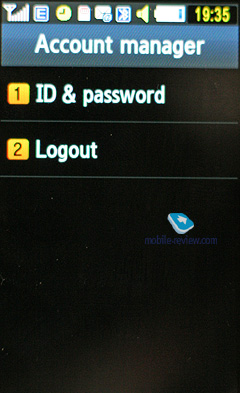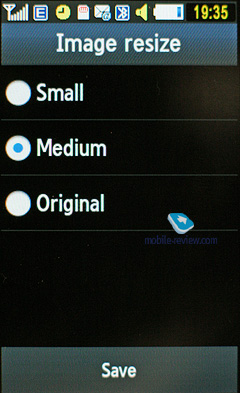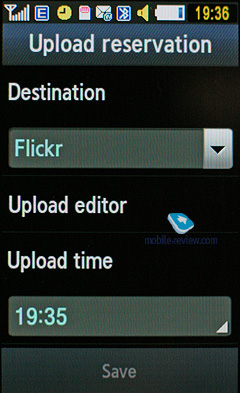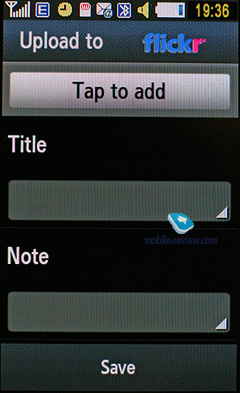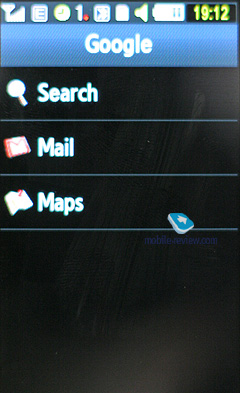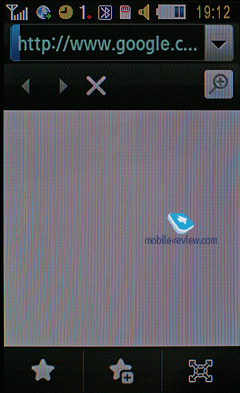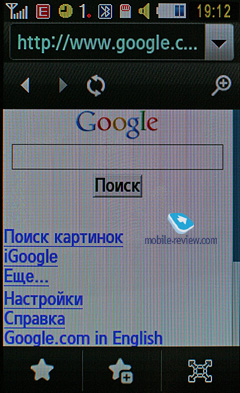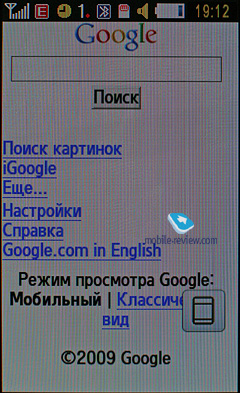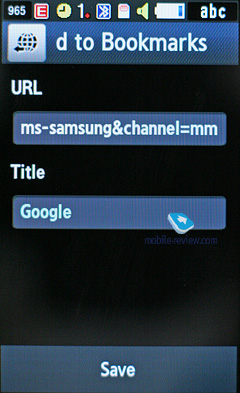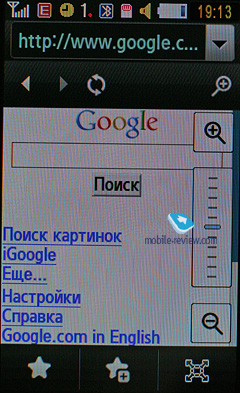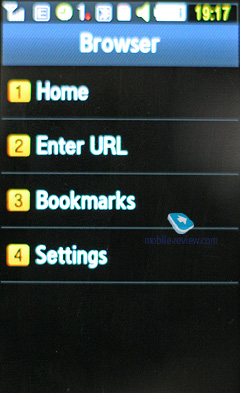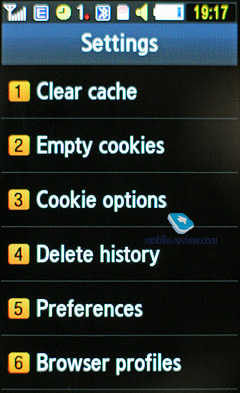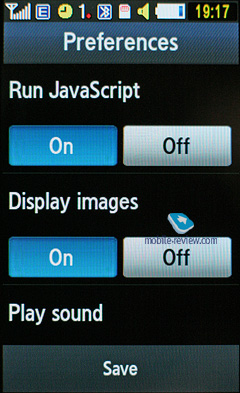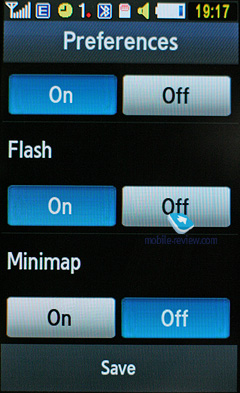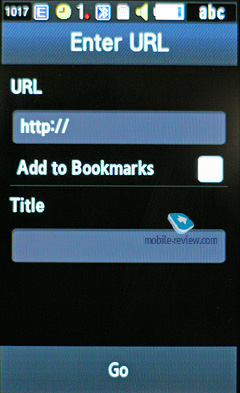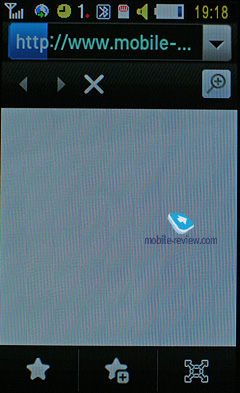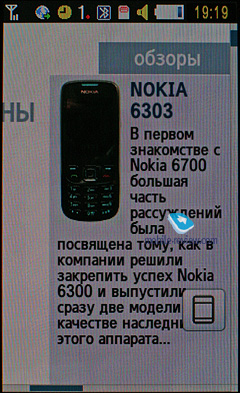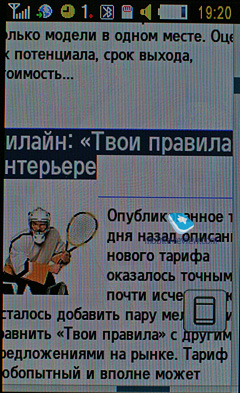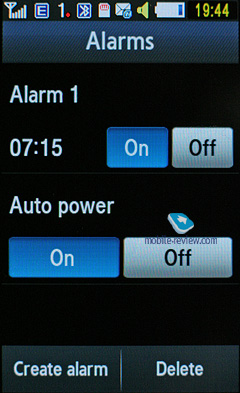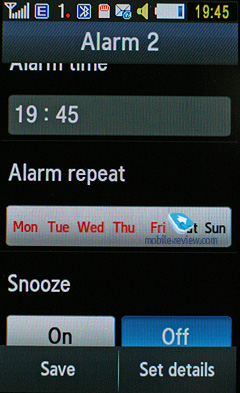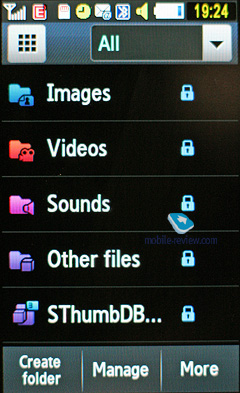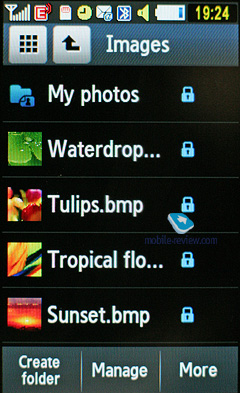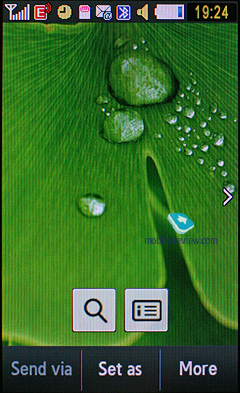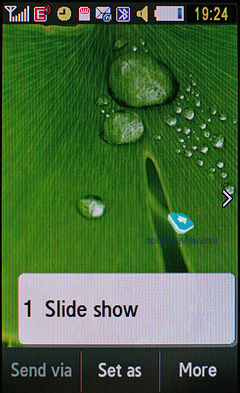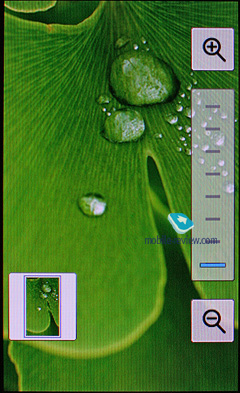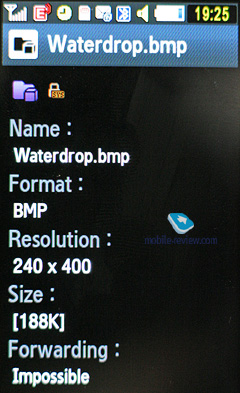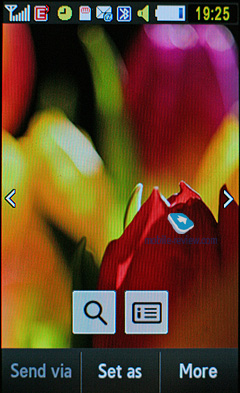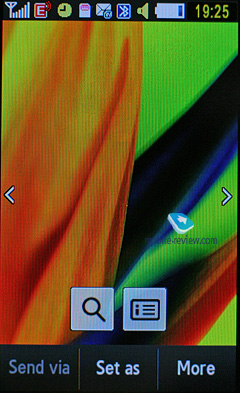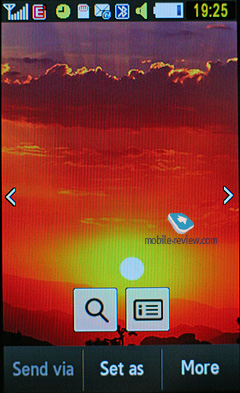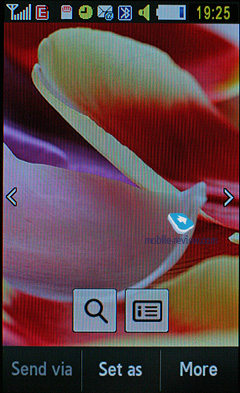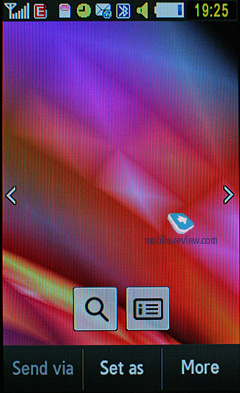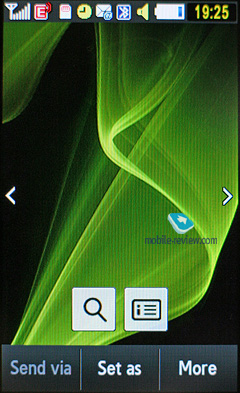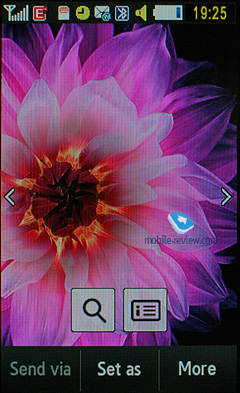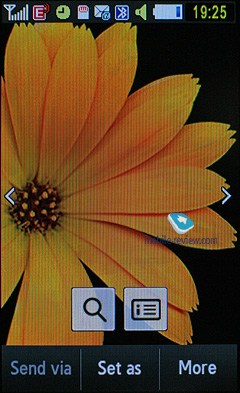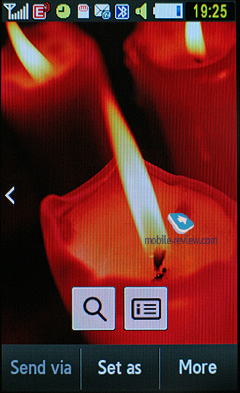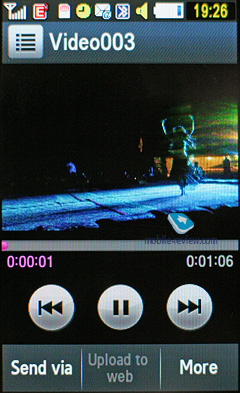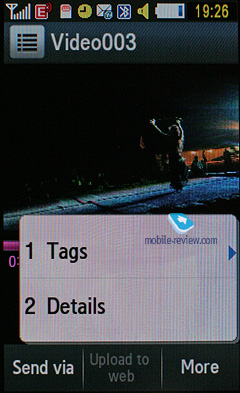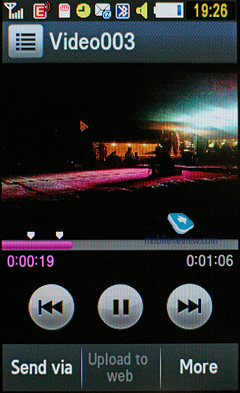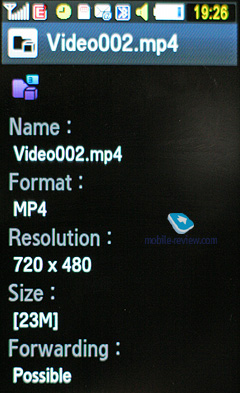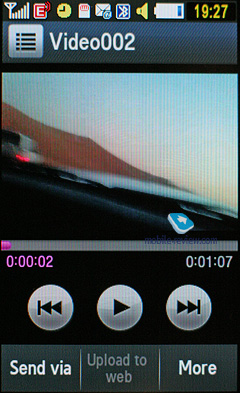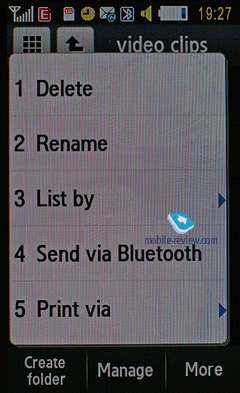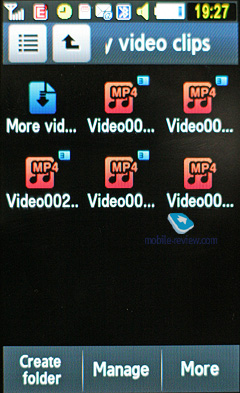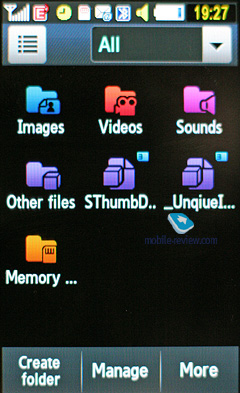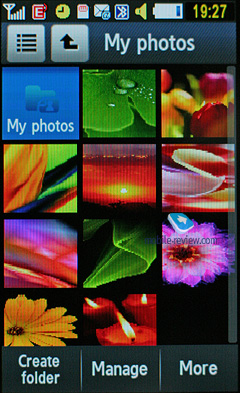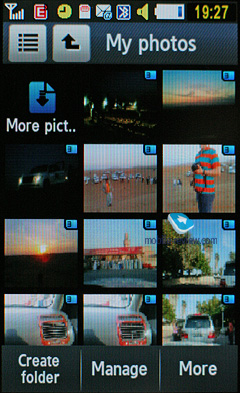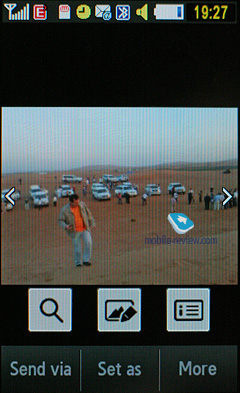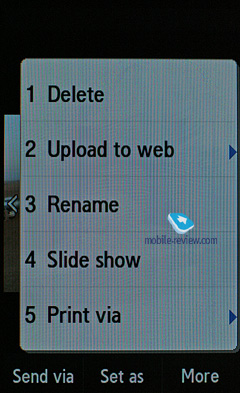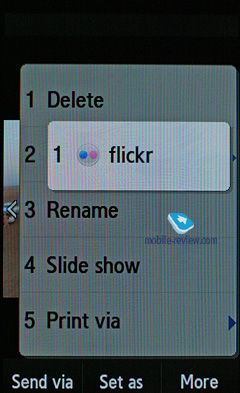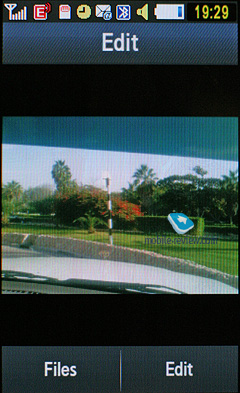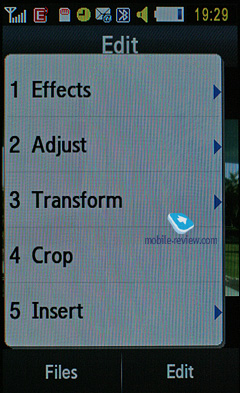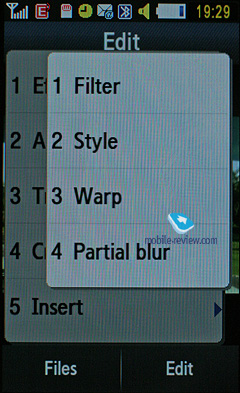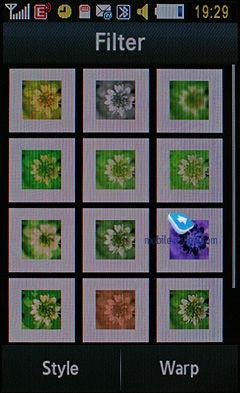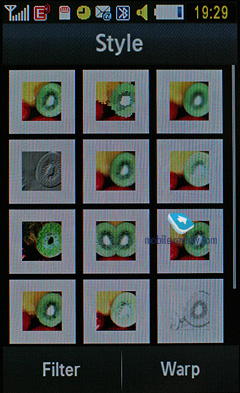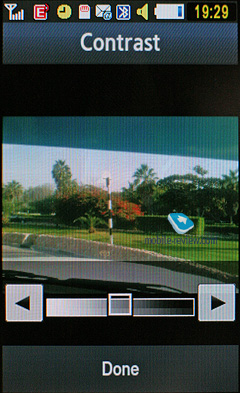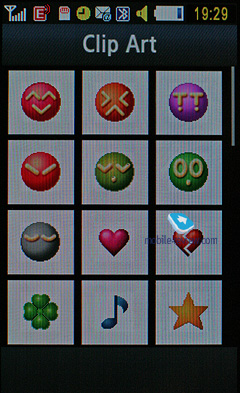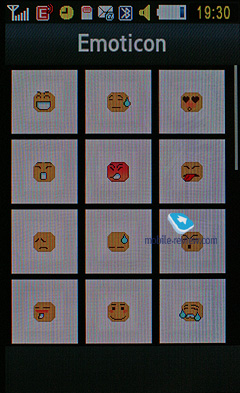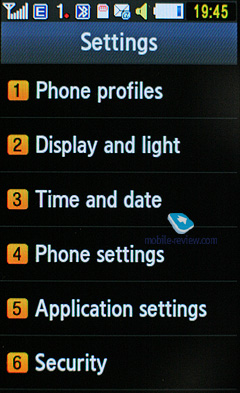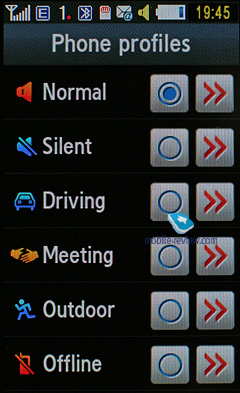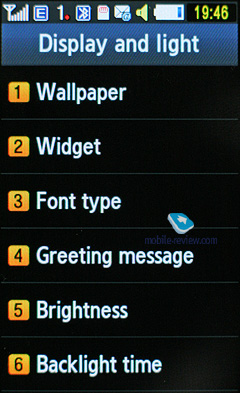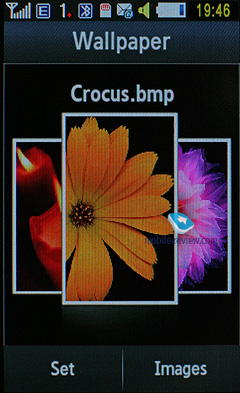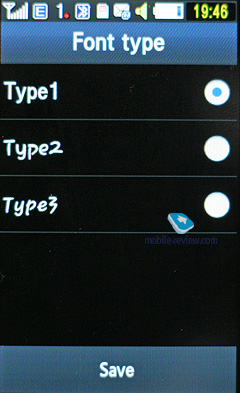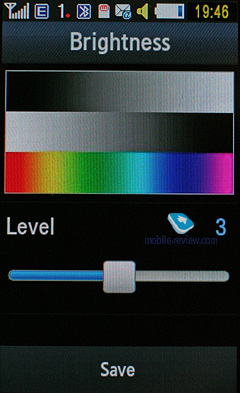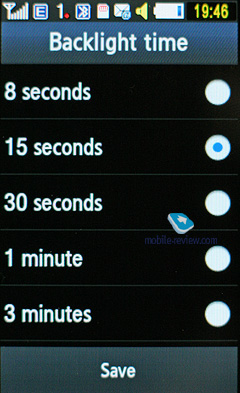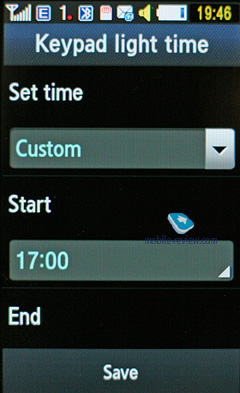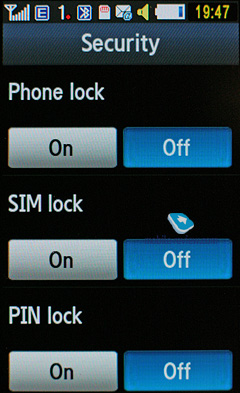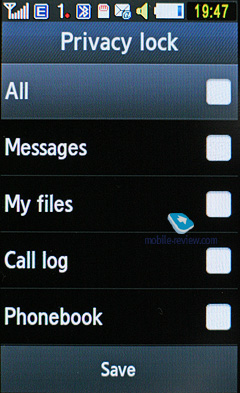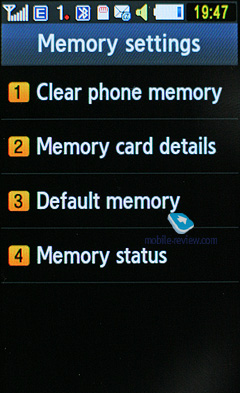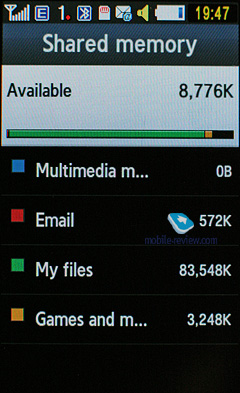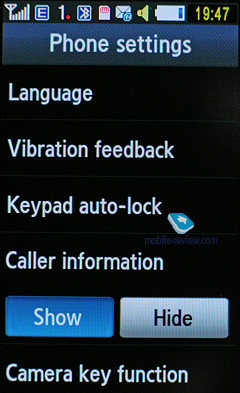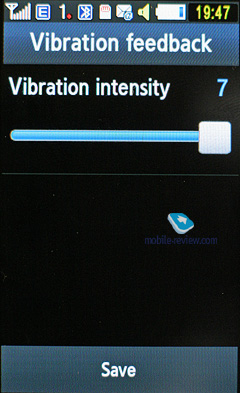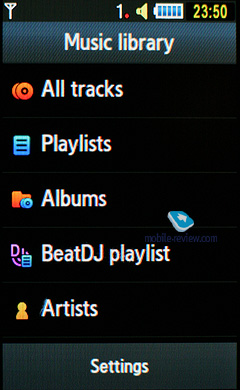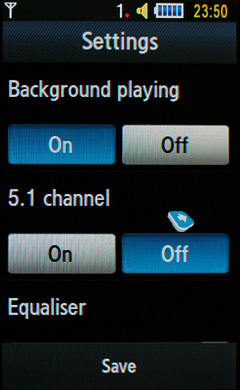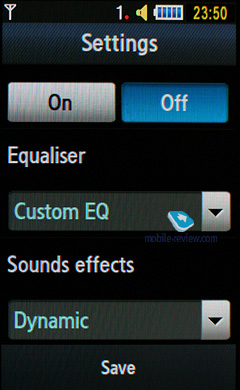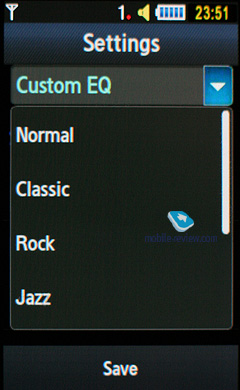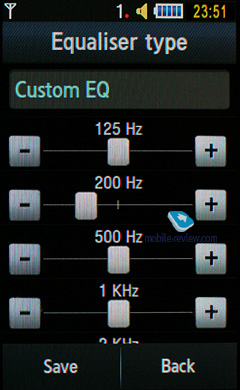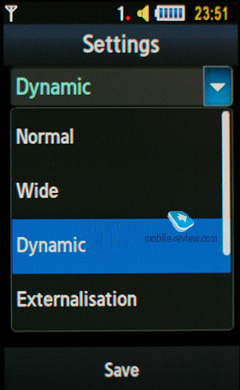|
|
Review of GSM/UMTS-handset Samsung Beat DJ (M7600)
Live photos of Samsung Beat DJ
Table of contents:
- Positioning
- Design, Size, Controls
- Display
- Battery
- Connectivity
- Memory, Memory cards
- Performance
- Camera
- Menu, User Interface
- Phonebook
- Call Log
- Messaging
- Organizer
- Applications
- Alarm Clock
- File Manager (My files)
- Settings
- MP3-player
- Watching video on the M7600
- Picsel Viewer
- Impressions
Sales package:
- Handset
- 960 mAh Li-Ion battery
- 4 Gb microSD memory card (size varies by region)
- Charger
- Wired stereo-headset with a 3.5mm socket
- User Guide
While this article is more of a preview of the Samsung Beat DJ, it’s safe to say that it won’t change much by the time it hits the shelves.
Positioning
As it stands today, Samsung’s portfolio has three flagship phones – the S8300 Ultra Touch, Beat DJ and Omnia HD. It’s pretty clear what role each phone plays – the S8300 offers all state-of-the-art technologies in the slider-type design and is more or less aimed at the mass market, the Beat DJ is a true jukebox and a reaction to the latest efforts of Nokia and Sony Ericsson on this field, while the latter is the ultimate imaging-centric device. Interestingly, there are worlds of difference between these three handsets in terms of style, pricing, positioning and other characteristics, so there is no point in assessing the extent to which they will interact on the market. However when it comes to hardware, things don’t seem to be as simple – the S8300 and M7600 are based on the same platform, and what’s more their technical specifications are nearly identical, bar the latter’s music department. So, having thrown in an enhanced music player, along with a pair of top-notch speakers and unconventional forms, Samsung have come up with one of the finest music-playing phones out there. But while its sound quality is superb, the question is whether it will be enough to win over the average consumer’s heart. Samsung already have vast experience with phones of this type and caliber, nevertheless one after another these offerings failed to conquer the market. The reason was that consumers saw no connection between “Samsung” and “top-quality sonic experience”, thus most of their music-minded solutions were welcomed mainly by people in the know. Unfortunately, the same will hold true for the Beat DJ.
One thing of note about the M7600 is that it’s set to hit the market along with another music-focused phone, the M6710, also known as the Beat Disc that comes in a different casing and with a couple of downgrades, plus it won’t be available on most markets. I suppose this review will cover both devices, since the only major difference between them lies in design.
Samsung Beat Disc (M6710):
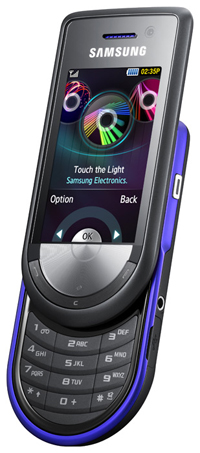
Samsung Beat Disc Beat DJ (M7600):


We won’t even bother explaining what audience Samsung targets the M7600 at – the way it’s positioned is extremely questionable and for the most part has got nothing to do with reality. In my opinion, they’d be much better off focusing on 15-25 y.o. men who aren’t afraid to seem different, plus value substance over style. In other words, they shouldn’t be worried about sounding ridiculous when claiming that a Samsung-branded phone offers better music quality than a player from Apple. It does, so why would they need to keep mum on that. We’ll get back to this issue a bit later, though, and for now let’s continue to examine the Beat DJ’s target audience. It won’t see many young women among its users, although the shape it comes in is pretty offbeat (and at the same time it’s exactly the reason why adults will shy away from the Beat DJ).
Back to the table of contents >>>
Design, Size, Controls
The Beat DJ’s design stands out among other music-playing phones, and is actually its greatest weakness as well, since these quirky shapes can easily put many off. All in all, the Beat DJ has got a very unique style, and while some claim that it reminds them of the Sony Myle, in my mind it bears some resemblance to the Motorola v80.
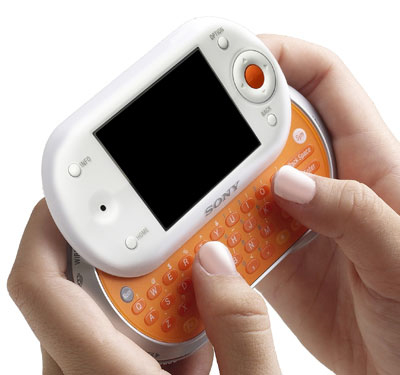
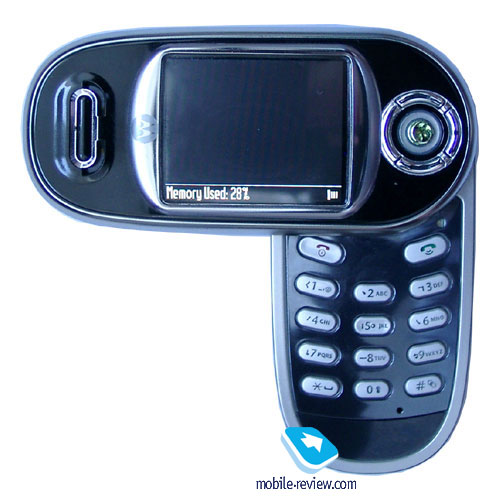
The first thing that goes though your mind when you grasp the Beat DJ is that it’s pretty big, although it’s more of an illusion – in reality it measures 111x51x14 mm and weights 100 g, so it’s not cumbersome at all. Most users won’t run into any difficulties regarding the Beat DJ’s size, and will certainly appreciate the ability to carry it on a lanyard.

Samsung S7600 vs Samsung S8300:


Thanks to its rounded shapes the Beat DJ is a very palm-friendly phone. As far as its controls go, on the left there is the volume rocker along with keypad lock switch, dedicated music player button and microUSB socket covered by a plastic flap.


Housed on the right is the camera button and microSD memory expansion slot. The 3.5 mm audio jack is placed on the top end.

The display is framed by a chromed metal strip. There are only three buttons on the front fascia: Call, End and Back. However, since the Beat DJ comes equipped with a touch-sensitive display it’s difficult to image that you’d need more. Perched above the earpiece is the ambient light sensor as well as the proximity sensor (locks the display when you take it close to your face) and forward-facing camera.

Regrettably, as far as colors go, there is not much to choose from, since the Beat DJ comes in only one color scheme with violet side plates and patterned plastic back cover.



Back to the table of contents >>>
Display
The M7600 comes bundled with a 2.8 inch widescreen display, capable of 240x400 pixel resolution (36x62 mm, AMOLED) and 16 million colors – exactly the same unit is found in the Samsung S8300.

All data input is done via this touch-sensitive display, running the Capacitive Touch Screen technology - in other words, unlike more conventional touch-screens, it packs no sensors and rather employs a special oxide layer on top of its screen, which reacts to touches of your fingers, basically, a stylus or any other sharp object won't do here. With a pair of gloves on, you will still be able to use the M7600's hardware buttons, while typing up a short message will prove to be impossible.
Among this technology's edges is the display protection, be it plastic or glass, which provides a higher degree of safety than on standard touch-sensitive panels (the M7600 employs a plastic screen). Also with the M7600 it doesn't matter how dirty the screen's surface actually is - you will still get pretty decent reaction time and accuracy. The display itself is slightly sunk into the casing (which doesn’t affect its ergonomics), so you won’t have to worry about it getting scratched when you put it face down.
Samsung-branded offerings also employ the VibeZ feature so as to make the casing vibrate a little, confirming your actions, and we do mean "actions", since it gives you an unobtrusive buzz whenever you tap some action-related keys.
The display accommodates up to 14 text and 3 service lines, but you can cram as many as 24 lines into it when reading a message, depending on the font size you have picked. The volume rocker now lets you scroll through pages back and forth and doesn’t change font size anymore (like in the M8800). What really matters is that unlike most other offerings, the M7600 sports huge-ish font sizes, which are very readable from almost any distance.
The M7600’s display gets washed out under direct sunlight, which hurts it legibility, but it still fares better than the M8800 Pixon.
The phone also houses a motion sensor that allows the display to re-align the image whenever you turn it.
Back to the table of contents >>>
Battery
The handset utilizes a 960 mAh Li-Ion battery, rated for 350 hours of standby and 5 hours of talk time. In Moscow the M7600's battery time averaged around 2 days (a bit over one hour of calls, a couple of messages a day, very little email and up to four hours of radio/music). Those who are into mail and web, will be able to squeeze around a day of life time from the M7600. But in general, this handset can stay up and running for 1-2 days hands down. Unfortunately, there is no high-capacity batteries available for this handset. It takes the phone around 2 hours to charge up.

Back to the table of contents >>>
Connectivity
Bluetooth. The model supports various profiles, such as Headset, Handsfree, Serial Port, Dial Up Networking, File Transfer, Object Push, Basic Printing, A2DP. EDR-enabled Bluetooth 2.1 is onboard. Wireless headsets are handled by the M7600 with ease.
USB-connection. In the menu you may select one of three modes: Media, Mass Storage, Samsung PC Studio. When connected to a PC via USB, the P8300 automatically recharges itself.
While in the USB Mass Storage mode, the M7600 shows up on the desktop without requiring you to install any additional drivers, so right after plugging in it's ready to work. Data connection speeds top out 1200 Kb/s.
You won't be able to use the M7600's Bluetooth connectivity along with USB - it will require you to disable Bluetooth regardless of its status (connected and transferring data or not), which is very awkward.
There is also EDGE class 10 connectivity for GSM networks.
Back to the table of contents >>>
Memory, Memory cards
The phone ships with 90 Mb of onboard memory - this storage space, give or take, is available to the user right out of the box. The memory card is displayed as a separate section, but you can also view both memory card and internal storage at the same time. The M7600 also comes with a file manager, enabling you to copy files to/from the memory card. In our test the handset had no problems handling a 32 Gb microSD memory card.
The memory card slot is perched under the phone’s battery, so you will have to power it off first.
We didn't like how long it took the M7600 to copy files from the bundled storage onto a memory card - actually, it managed to move a 50 Mb file in 7 minutes or so, which is pretty slow by today's standards.
Back to the table of contents >>>
Performance
The M7600's performance will hardly blow you away - it's pretty much in one boat with other latest and greatest offerings from Samsung, although it has got some distinctive touches to it. That is, it can multitask with Java applications, meaning that apart from closing an app you can minimize it and call it back to the top later on. On the down side, however, there is no task manager to be found, so you'll have to dig through the phone's menu to bring minimized applications up (you'll see a distinctive icon next to all currently running applications). Using the phone's Connectivity settings you can set up a background Internet connection to run for Java applications, allowing you to keep an IM client and some other apps in the background (we managed to have 8 apps running at a time). The M7600 also supports 3D JSR, including all JBenchmark tests. As far as Samsung is concerned it's a huge leap forward considering how hobbled the Java machine on their previous offerings was. Also, from now on you can install new applications not only over the air but from the phone's internal storage and memory cards as well. Java apps can't exceed 1Mb in size.
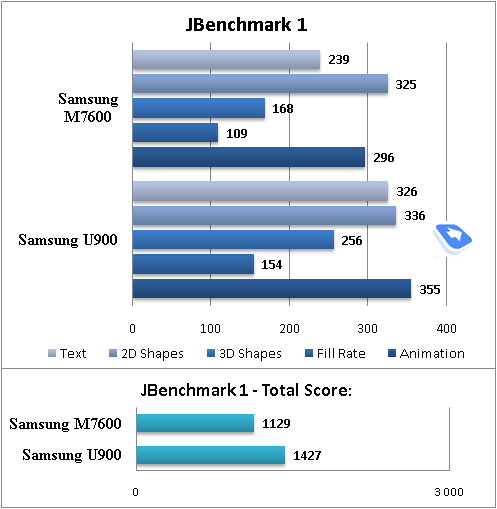
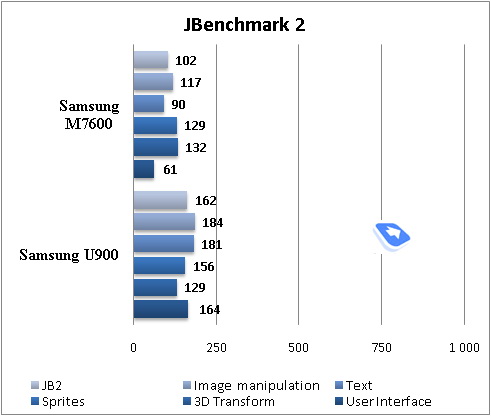
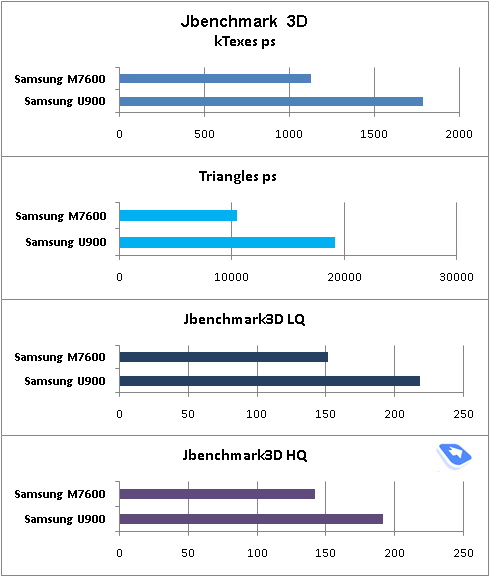
Back to the table of contents >>>
Camera
The S8300 camera’s specs are as follows:
- 3 Mpix CMOS module, ? inchóû
- x4 digital zoom (no optical zoom, regrettably)
- LED flash
- Miminun macro distance – 10 cm
- Face Detection/Smile modes
The M7600 enjoys a landscape camera interface and allows the user to tweak all settings and change options on the fly by simply tapping on thumbnails you need right on the screen. Needless to say, this makes the phone’s camera app a breeze to work with.
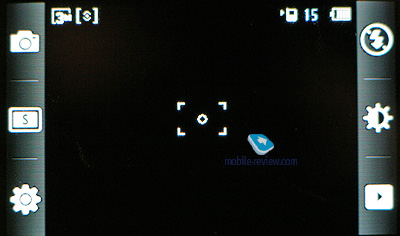
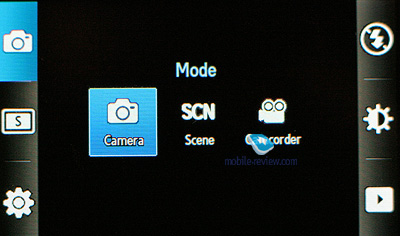
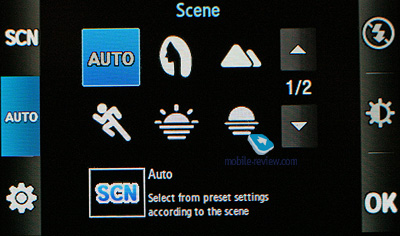
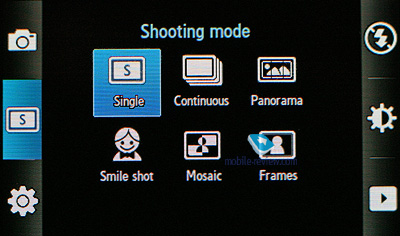
The phone also comes equipped with a GPS receiver that, however, keeps a low profile in all menus except for the camera app, where it enables geo-tagging.
Resolutions:
- 2048x1536
- 1600x1200
- 1280x960
- 640x480
- 2048x1232 (wide)
- 400x240 (wide)
Shooting modes:
- Single shot
- Multi-shot
- Frame shot
- Mosaic shot
- Panorama shot
- Smile shot
Scenes:
- Portrait
- Landscape
- Sports
- Indoor
- Beach
- Sunset
- Dawn
- Waves and snow
- Night shot
- Against light
- Fireworks
- Text
White balance:
- Auto
- Daylight
- Incandescent
- Fluorescent
- Cloudy
Effects:
- Black and white
- Sepia
- Negative
- Watercolour
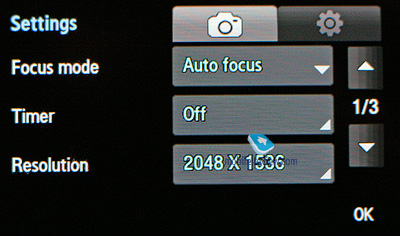
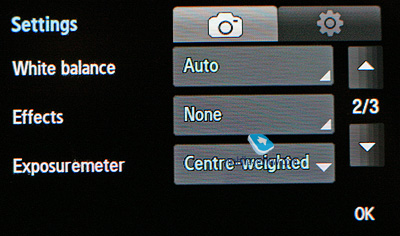
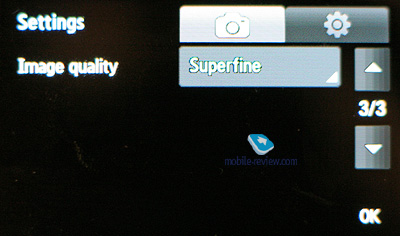
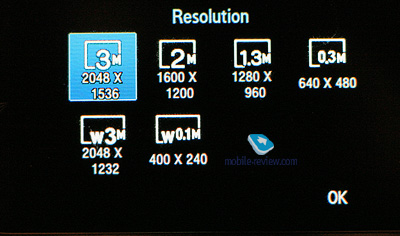
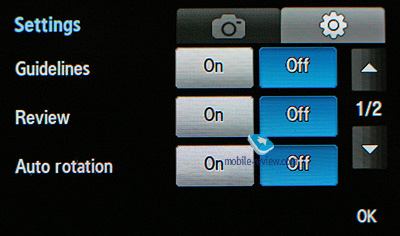
Also there the M7600 features macro mode onboard.
Using the settings menu you can select a special mode for shooting text fragments, although you probably will never have to turn it on, since even in the Auto mode the M7600 does a great job adjust all options and settings for crystal clear snaps.
 |
 |
| (+) enlarge, 2048x1536, JPEG |
(+) enlarge, 2048x1536, JPEG |
 |
 |
| (+) enlarge, 2048x1536, JPEG |
(+) enlarge, 2048x1536, JPEG |
 |
 |
| (+) enlarge, 2048x1536, JPEG |
(+) enlarge, 2048x1536, JPEG |
 |
 |
| (+) enlarge, 2048x1536, JPEG |
(+) enlarge, 2048x1536, JPEG |
 |
 |
| (+) enlarge, 2048x1536, JPEG |
(+) enlarge, 2048x1536, JPEG |
 |
 |
| (+) enlarge, 2048x1536, JPEG |
(+) enlarge, 2048x1536, JPEG |
 |
 |
| (+) enlarge, 2048x1536, JPEG |
(+) enlarge, 2048x1536, JPEG |
 |
 |
| (+) enlarge, 2048x1536, JPEG |
(+) enlarge, 2048x1536, JPEG |
 |
 |
| (+) enlarge, 2048x1536, JPEG |
(+) enlarge, 2048x1536, JPEG |
Video
You can record video clips in VGA resolution at 15 FPS. When capturing videos you can zoom in/out and also apply one of the standard special effects.
Photo Browser. This application is a welcome addition to the M7600’s software department – as its name suggests, “Photo browser” kicks in whenever you feel like viewing your gallery. It allows using various filters when browsing your images, such as file name or prevailing color (other filters like folder name, face tag and date are also available). By the way, the face tag feature is something we haven’t seen on mobile phones yet. Here is how it works – when browsing the gallery, select the Face Link option – the phone will try to find a face in the image you are currently browsing and in case it fails, you’ll get to select it manually and add a tag or assign the fragment you selected to a contact in the phonebook right away.
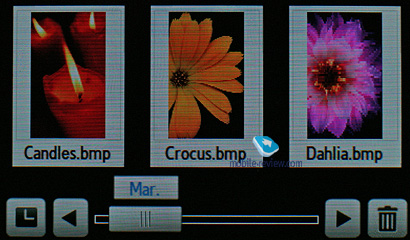
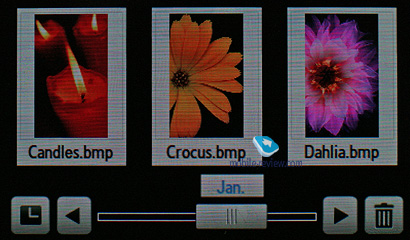
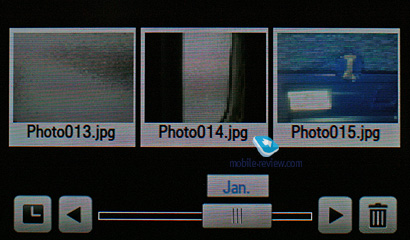
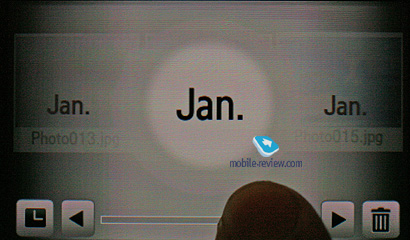
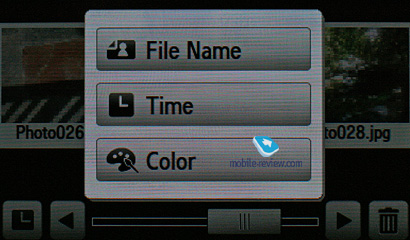
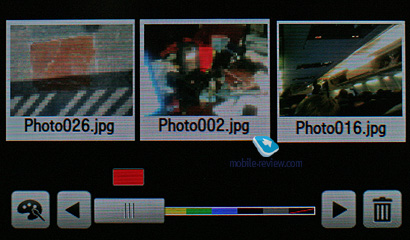
Among all other things the Photo Browser also features slide-show mode. But what we really liked about this application is that it allows scrolling through images not only with finger gestures, but also by simply tilting the phone right or left, and the lower one of the ends goes, the faster it jumps between photos, which is an interesting way to utilize the bundled motion sensor.







Back to the table of contents >>>
Menu, User Interface
In many ways the M7600’s menu and functionality are similar to the Samsung M8800 Pixon, although there are several subtle differences. While at the standby screen, the display’s base is occupied by a bar containing three shortcuts to the dialing screen, phonebook and menu. On the left is an arrow, tapping which will expand the applications bar, allowing you to drag any Widgets to the screen (their layout is also adjustable). Obviously, the M7600 looks so much nicer with only a handful of windows tacked on, rather than a cacophony of widgets all around its real estate. Let’s take a look at what things you can be up on the screen:
- Carrier name
- Date and time
- Analog clock
- Digital clock
- World time (for any chosen city)
- Player controls
- Radio controls
- Album with thumbnails (you can also scroll through images with it)
- Games shortcut
- Events (missed calls, SMS)
- Birthday reminder
- Profile switcher
- Five favorite contacts – you can call them or send SMS, all in one touch
- Mirror – uses the forward-facing camera to show what’s going on right on the screen
- Google search
- Quick access to Samsung’s Fun Club
- Alarm Clocks
- AccuWeather forecast – somewhat similar to the visual effects found in HTC’s Touch Diamond
- Stop Smoking – counts how many days you haven’t smoked
- Stop diet – counts how many days you’ve been on a diet
- Widget uploader
It’s easy to see that Samsung’s Widgets allow the user to tune and tailor the display’s layout to his/her own liking. Unfortunately, sooner or later you will run into the only real limitation of the M7600 in this department – physical size of the screen; naturally, we’d like to be able to cram more elements into it. But, it is what it is today, even in this state Widgets is the most flexible solution out there and it’s definitely ahead of Nokia’s Active Standby.
The M7600 boasts almost twenty widgets, along with a download manager that enables the user to upload new ones from Samsung’s web site. Needless to say that no other phone maker can offer anything even remotely as flexible as the M7600’s standby screen.
You can enter the main menu by pressing the icon at the bottomof the screen. The main menu is displayed as a 3x4 grid. The touch-sensitive display is easy to handle – you tap the item you need, then bring up a data input field by double-pressing it, since the first one will select it, and the next one will enabled the on-screen keypad. If the phone is slid open, the user is offered to used the hardware buttons, otherwise the only way to go is the M7600's on-screen keypad.
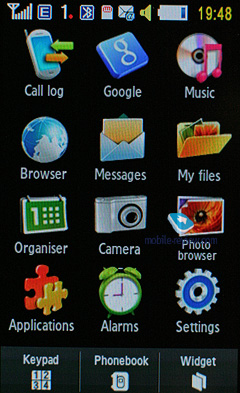
All texting is done via the on-screen keyboard, which is almost identical to that of conventional looking handsets – it houses twelve buttons with a batch of symbols attached to each, so in order to type some particular letter you will need to tap one of these buttons sequentially. While the Samsung M8800 Pixon sported a virtual thumbboard on top of that, the M7600’s smaller display made it awkward to use, so they opted to remove it from the standard package.
Another thing that has gone through a major revamp is the predictive input system T9. You can enable it both for the numberpad in one touch. The good thing about the M7600 is that it tries to predict what letters or words you will punch in next and therefore makes it a lot easier to pick word endings by simply tapping on them.
All applications feature a context-sensitive tool bar at the foot of the screen.
Another area where the M7600 improves over its predecessors is scrolling – sliding your finger down on the left will make lists scroll through much faster than if you were doing that on the right. In case the list you are browsing features names, you can always opt to jump straight to some particular letter, like in the gallery.
Back to the table of contents >>>
Phonebook
You can call up the phonebook by tapping the shortcut at the standby screen; you will see a list that contains all entries from both the SIM-card and phone’s memory. On the left there is a magnifier-shaped shortcut that allows scrolling all the way down to the letter you need. The drop-down list in the top right corner allows sorting the list by entry types – contacts, groups or favorites.
The only view available for the phonebook is a plain list with contact names – you won’t be able to browse assigned images or phone number right there, to do that you will have to enter the detailed view.
You can assign any image, photo or video clips as caller ID. Each entry can have up to 5 phone numbers of different types (mobile, office, home, fax, and other), one of them will be the main number (by default it is the first one you entered). All fields are customizable.
There are two lines for First Name and Last Name (search is performed only by the former), these fields get merged when displayed in the general list, and First Name comes first. For example Eldar Murtazin will be shown only in this order. The length of each field is 20 characters for any supported input language. You can also switch languages on the fly when entering a name.
All entries, regardless of language, are sorted out in the following way – all contacts with headings made in a local language (Russian, for example) go first and then those with names in English. This is a rather convenient and handy list sorting system. Taking into account fast language switch option during the search, it’s clear that no language will spoil the experience of working with this phone. The list can be sorted by first or last name.
But let us return to the information entered for a contact. Apart from phone numbers, e-mail address (there may be several of them), a little text memo can be submitted on top of all that. Any music file (including MP3) can be picked as a ring tone for a contact. Three caller groups are provided by default with the possibility for creating any number of additional groups, setting a personal melody and image for each (by default there are three groups). SMS alerts are not customizable.
The phonebook is capable of holding up to 2000 contacts with filled in data fields. Even if all the available blanks are not used, the cap won’t get any bigger and will still make two thousands. It is possible to specify in the settings where all new numbers should be kept by default. There is also an option for moving entries from the SIM-card, although the reverse action is denied. According to the developers, PC (MS Outlook in particular) is best for data synchronization with the M7600. Any contact in the form of SMS/MMS, mail message or other text file can be quickly sent through Bluetooth to another device. There are no problems with sending, and the phonebook entry gets beamed to another device, where it is read without any trouble.
The phonebook may contain a business card as well, though its structure copies all the fields found in a regular contact in the phone book.
There can be up to twelve numbers in the fast dial list; separate numbers tied up with a single contact may appear on this list as well.
You can create any number of caller groups, assign up to 20 contacts and customize them with a picture and tune.
On an incoming call, the caller ID picture occupies half of the screen, but that doesn’t make indiscernible.
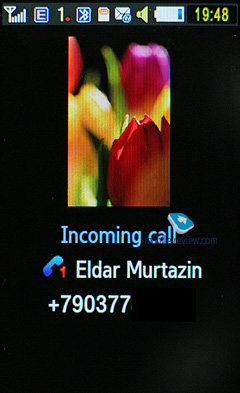
Back to the table of contents >>>
Call Log
Each of the given lists contain up to 30 phone numbers. There is a combined list of all the last calls with an icon indicating call type. You can quickly switch between the lists. The date and time of the calls are displayed in the extended view for separate entries. Calls from/to one number are grouped up, so that the number standing next to the call specifies total number of calls made. As always, the overall time of the calls and their cost can be viewed in this menu (in the case that the service has been enabled).
For certain numbers you can arrange a black list that will reject all calls coming from these contacts.
Also there is a separate list for sent messages.
Back to the table of contents >>>
Messaging
Much like other makers, over at Samsung they have forgone that artificial division into SMS-MMS types – you just start composing a message, and only then, depending on the contents, it is attributed to SMS or MMS. The menu still holds an option for switching message into MMS mode (for example when you need to send only text, but to an e-mail address, without calling up the bundled client).
The phone memory can hold up to as many as 500 messages; the handset supports EMS standard compatible with Nokia Smart Messaging. While choosing recipient, you can either select a telephone number from your contacts, or pick one from the call lists or groups. All messages are manageable, this means you are at liberty to move a certain number to your black list, in order to make sure all messages coming from that phone number will be deleted automatically; possibility for moving messages to any folder of your own is also at your disposal. For e-mail, you can move not only addresses to the blacklist, but unwanted subjects as well.
There are no size restrictions as far as received messages go, though an outgoing message’s size is limited to 295 KB. As for additional services available with the M7600, message rejection and message retrieval type options are onboard. All messages are stored in general dynamic memory, the same goes for e-mails.
Also there is a useful function for sending SOS-messages – when activated, should you find yourself in an emergency, after pressing the volume key four times, the message «I am in emergency. Please help me» will be sent to contacts submitted earlier, all incoming calls from these numbers upon sending the emergency message will be picked up automatically. Recipients (not more than 5), as well as the number of Repeats may be set up manually, while the text of the SOS-message is not customizable.
The bundled mail client is standard in all its components – 5 accounts and the maximum of 100 incoming messages; attachments are also handled by the phone, though there are also several caps – there’s no way you can receive a file more than 5 Mb big, or send one with size exceeding 5 Mb. Received files can be viewed via the bundled browser. The M7600 doesn't support HTML in e-mails, which breaks formatting of most letters you receive, so they become really awkward to read.
Also, the M7600 features a setup wizard for the mail application that will walk you through all essential options and settings.
Back to the table of contents >>>
Organizer
The phone’s memory can store as many as 300 events of one type – meeting. Day and time as well as end time of an event are indicated for each entry. Alert signal and its duration can be adjusted to your liking; repeatable events are available for setting up (repeat time is also manageable as well as the exceptions). The week and the month calendar views are very convenient with each type of the event having its own color.
Unfortunately, you can’t start setting up an even by tapping on some day in the Calendar; plus the M7600 doesn’t show three upcoming events for any selected day in the Month view because of its smaller diagonal.
Memo – standard text notes..
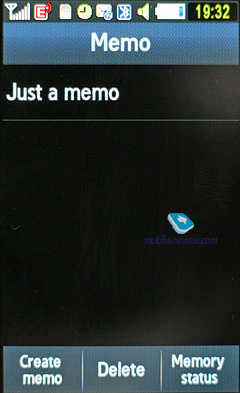
Tasks – a to-do list allowing you to set different priorities and adjust alarms for up to 100 tasks.
World time. is displayed for two chosen cities.
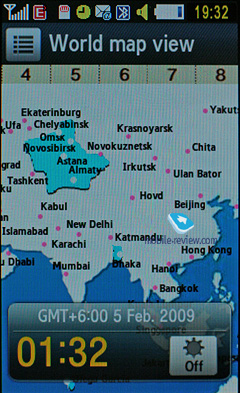
Calculator – It divides, multiplies, subtracts and adds and does several more things – quite enough for a mobile calculator.
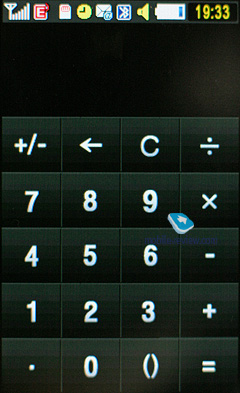
With the Converter you can operate with different units of measurements as well as with a number of currencies.
Back to the table of contents >>>
Applications
FM-radio. You can store up to 99 radio stations in the memory; the range of available frequencies is 87.5-108 MHz. Also, you can enjoy auto-tuning, but particular channels cannot have own names attached – they are always shown as frequencies. The radio implementation is fine, although it doesn’t pick up all stations equally well, but on balance, it is quite competent in comparison to other vendors’ offerings. The radio can be minimized.
RDS here displays only the station’s name in the general list, no advanced options available
Voice recorder. You can record up to several hours of voice memos with the number of files being unlimited. Basically, limitations on recording duration are set by the user himself, though length of a single recording cannot exceed 1 hour. All the files are stored in a separate folder in the memory bank. The recorder performs well during lectures, conferences and presentations – I could even say that it is a partial substitute for a digital tape recorder.
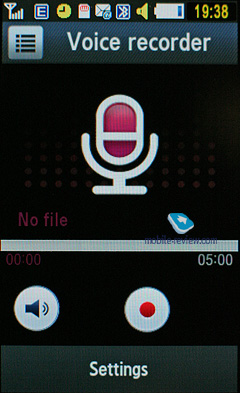
Countdown timer and Stopwatch have no bells and whistles.
RSS Reader. This is a stand-alone utility for RSS feeds. However, it would make more sense if the RSS Reader was bound up with the web-browser, but this is not the case with the M7600. This way, RSS links are not picked up by the browser, or sent directly to the application. You will need to manually submit a channel address in this app to subscribe, or enter a web address and let the application try to find an RSS channel on it.
While uploading your news feed, the M7600 can upload text, as well as video and audio files, and it is up to you to set the size limit (by default – 5 Mb per file). Regrettably, there no scheduled feed updates are available, thus you will need to refresh the feed manually every time you need hot news.
Bluetooth. As far as this app’s outfit goes, it has definitely been reworked thoroughly in the M7600 – now you can view the device map (like in some wireless managers on desktops) or opt to browser the standard version of device list. In terms of Bluetooth, the M7600 is a full-spec solution that won't let you down.
Games. The M7600 can multitask with Java applications, meaning that you can fire up a couple of programs, minimize them and bring them back to the top whenever you please. The games pool may vary by market; our unit features a full version of Checkers Deluxe and demos of BrainChallenge, DiamondTwistter, Millionaire 3 and PyramidBloxx.
Browser – read our lowdown on the browser below, in the section titled “Google”.
Share Pix – this utility will soon become a part of the default feature pack in many Samsung-branded phones. It allows setting up an account with one of image-sharing services, so as to make the phone tag and send all your images there without your help. However, when there is no WiFi network to tap into, the M7600 will use your carrier’s data connection, which will result in quite hefty bills should you leave this feature enabled.
Google. This menu features Google search, Gmail and Google Maps applications. Let’s start with the latter – there are no bells and whistles in the M7600’s version of these maps, however its 3.2-inch diagonal does make scrolling through them a much more gratifying experience. On top of that you can jump between satellite and street views, although the satellite images seemed somewhat rough to me, compared to other phones with this feature onboard. But probably it’s more due to the fact that the M7600 boasts a sizable diagonal, but lacks in the way of resolution. The phone pinpointed our location via cellular networks without any problems, so all in all, we have no gripes with this department.
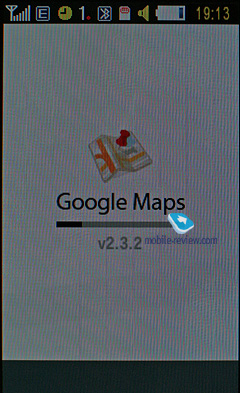 |
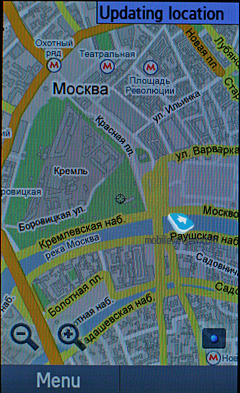 |
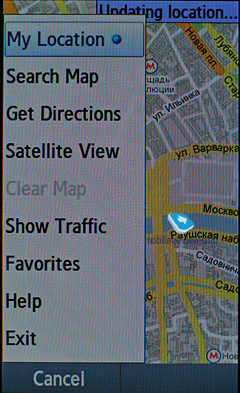 |
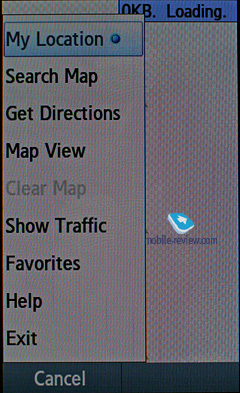 |
The phone comes preinstalled with NetFront 3.5 (WAP-browser ver. 2.0), sporting an improved page rendering algorithm that makes the whole process even smoother and faster. On the downside, unlike its Windows Mobile edition, this browser doesn’t have such a wealth of extra options and abilities.
Apart from JavaScript support, fonts scaling (three types), Smart-Fit (single-column view), full-screen mode (all controls are hidden), page caching, they have embedded a new feature – on-screen ‘mouse’ pointer. Much like Nokia’s S60-powered handsets and Opera Mini, you can view pages with a tiny navigation window displayed. The browser itself packs a lot of goods under the hood and will be appreciated by most users.
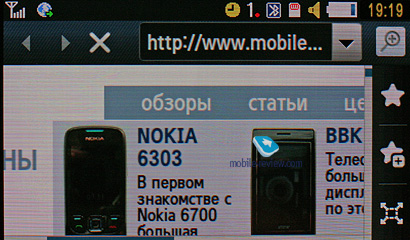
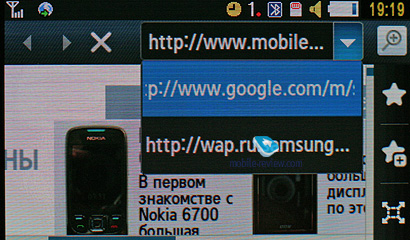
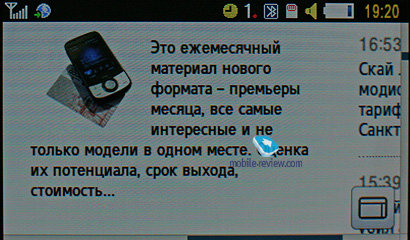
Back to the table of contents >>>
Alarm Clock
You can set up a number of alarm clocks in one touch or enable/disable the ones you have already created. Every alarm is fully customizable – you can pick any day you want and also use a custom tune.
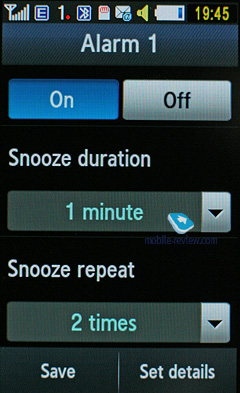
Back to the table of contents >>>
File Manager (My files)
That’s the place to search for all files such as music, pictures, video and sounds. Any uploaded file gets stored here. The disadvantage is that files sometimes are not displayed in the list immediately - in that case you will need to leave the menu and enter it again.
Files and folders can be viewed either as a list or thumbnails. You can mark any number of files. The handset supports Move, Copy and Delete operations, as well as various types of sorting (by type, name or size).
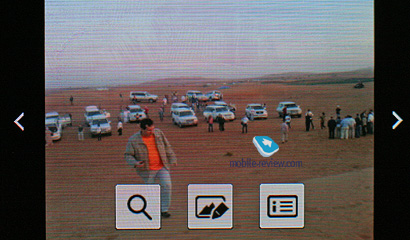
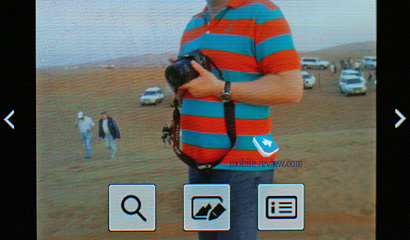
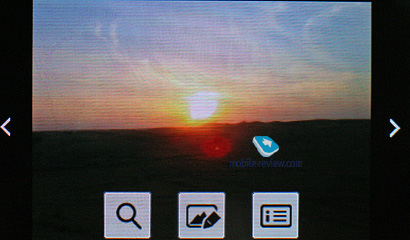
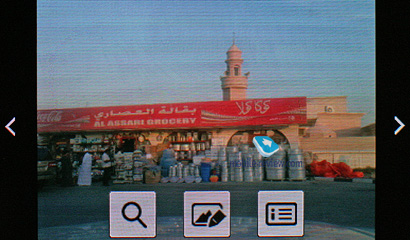
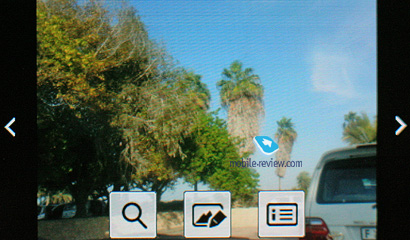

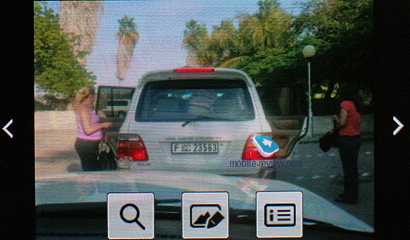
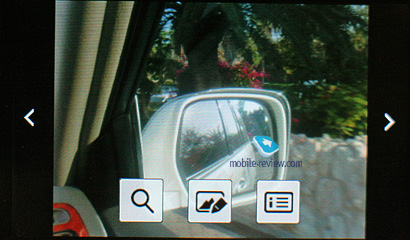
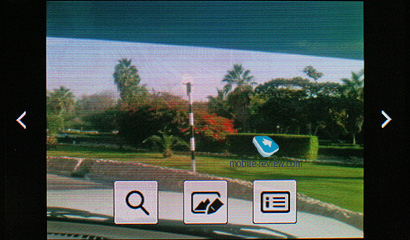
Back to the table of contents >>>
Settings
Traditionally this item boasts a standard set of options inside like password protection of selected sections. No special or quaint settings are available with the M7600. It only comes with an assortment of wallpapers and the ability to swap them randomly. The M7600 comes preloaded with profiles enabling the user to change the settings momentarily.
The font size, as well as its color and style are also adjustable.
The user can also modify vibration power for the VibeZ.
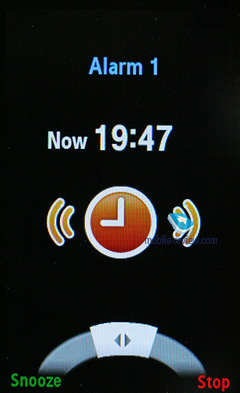
Mobile Tracker – submit a phone number, where notifications will be sent to in case SIM-card was changed - that message will contain number of the SIM-card being used with the handset. This section is protected with password, so that no one other than you or someone else who knows the password could disable the Tracker. Should your device have the SIM-card switched once, the specified number will receive one message instantly, and one more each time a new card is plugged in. A fetching feature which can prove to be of much help in case the handset is lost or stolen.
Back to the table of contents >>>
MP3-player
The Beat DJ’s player is called Disk UI 2.0, although it’s based on Samsung’s standard player application that went through a couple of face-lifts. The biggest chunk of improvements is under the phone’s hood – it comes armed with B&O’s IcePower chip, as well as some components that were previously available only with B&O-branded handsets. All in all, the Beat DJ offers dazzling audio quality, make no mistake about that – it’s as good as the Nokia N91, and even a tad better.
Also, the Beat DJ does well as a jukebox thanks to the two speakers mounted on either side of the phone – they are quite loud, and yet manage to sound clear even at the highest volume levels.
The player app supports random, sequential and cyclic playback modes. The phone allows you to upload mp3 files into its memory over Bluetooth or via Windows Media Player and other music synchronization applications. Your music files can have any names and tags; including those written in languages other than English – the phone handles them very well. Bitrates don’t matter much either, plus the Beat DJ supports WMA, AAC, eAAC, eAAC+ on top of MP3.
The title of the currently playing track is displayed as well as the number of the remaining tracks. There is a handful of equalizers embedded into the M7600, however only one of them is adjustable. Plus the phone allows you to setup the player’s bass settings, which is a great feat to have, especially because they have a significant impact on how the Beat DJ’s sound.
The player boasts the following filters: all tracks, recently played, most popular, artists, albums, genres and composers. Filters may be edited in the Settings menu (so that they’ll take account of some particular options). The M7600 also sports Album Arts support.
The headset that comes in the box with the M7600 sports a 3.5 mm audio jack and offers pretty good sound quality in general. All in all, the Beat DJ is a very capable music-minded solution; it even boasts 5.1 mode that emulates surround sound effect that is similar to Motorola’s Spatial Audio found in their ROKR phones.





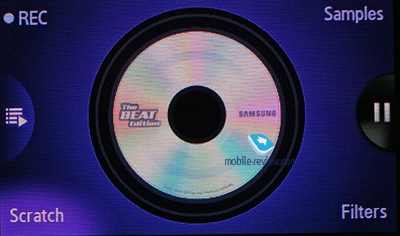
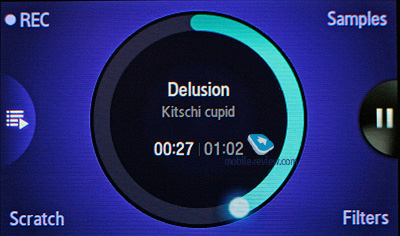
The headset that comes in the box with the M7600 sports a 3.5 mm audio jack and offers pretty good sound quality in general. All in all, the Beat DJ is a very capable music-minded solution; it even boasts 5.1 mode that emulates surround sound effect that is similar to Motorola’s Spatial Audio found in their ROKR phones.
Find Music (formerly known as Music Recognition) – a mere alternative to Sony Ericsson’s Track ID service. The gist of this service is this: you record a short clip from some music track you fancy and then the phone finds you its title and artist.
BeatDJ. This application is used for making up your own music mixes out of tracks stored on the phone. You can apply up to 20 effects, scratch the disc (rub the disc on the screen). In my opinion, though, this app will keep you entertained for half an hour at best – after all, you don’t need to make your own music to enjoy it.
Back to the table of contents >>>
Watching video on the M7600
Some words about how the M7600 fares on the video front – thankfully, its widescreen gives it all it takes for a decent experience. The phone supports mpeg4, H.263, H.264, DivX, which allows you to drag and drop movies onto the memory card. In fact, maximum file size is unlimited, at least in our tests we used 600-700 Mb movies and experienced no hardships with them.
But the biggest letdown here is also one of the best things about the M7600 – its display. Sounds awkward, right? However, if your video is 240x320 pixels big, it won’t occupy the entire display, since the handset can’t fit the picture into the screen size, leaving black stripes on all sides. Where the Apple Touch excels, the M7600 simply can’t make a movie look eye-candy. You can also opt for bigger video resolutions, but at the cost of having occasional freeze-ups and blockiness on the screen. All in all, we felt pretty content with the M7600’s 240x400 display resolution as far as videos are concerned. Another thing going for it is that you won’t have to convert movies before uploading them onto the phone.
Back to the table of contents >>>
Picsel Viewer
Putting it short, Picsel Viewer is an application that opens MS Office files (for instance, MS Word, Excel, PowerPoint), Adobe Acrobat (PDF), picture and video formats on the phone. The attraction of this technology is its speed, when a 20 MB PDF file takes a couple of seconds to open, then you can quickly page through it, zoom in/out and rotate pages. No editing abilities here, only viewing is available with the M7600, but that is pretty much enough already, especially considering there is no need in extra conversions.
Back to the table of contents >>>
Impressions
We never experienced any problems with the call quality the Beat DJ provided us with. On top of that its ring tones sounded loud and clear in most environments; the vibro alert didn’t disappoint us either.
Among all other things, the phone offers fast contact search, Fake Call and some other welcome features.
But the real centerpiece of the Beat DJ is its music department – if you consider its audio quality alone, it’s probably one of the most intriguing offerings out ther e, featuring a laundry list of settings and pretty decent bass. Apparently, its main target audience is comprised of younger people, so its price tag has been tailored for this consumer group in an appropriate fashion. When it lands on most markets in May, the Beat DJ will go for around 320 Euro, which is a great deal, considering that the S8300 is positioned at a significantly higher price point, even though its only real advantage over the Beat DJ is its 8 MP camera. Regardless, it won’t be a sought-after solution, but rather a true gem for those who value music quality among all other things and aren’t afraid to try new shapes and form-factors.
Related links
Back to the table of contents >>>
Eldar Murtazin (eldar@mobile-review.com)
Translated by Oleg Kononosov (oleg.kononosov@mobile-review.com)
Published — 26 September 2008
Have something to add?! Write us... eldar@mobile-review.com
News:
[ 31-07 16:21 ]Sir Jony Ive: Apple Isn't In It For The Money
[ 31-07 13:34 ]Video: Nokia Designer Interviews
[ 31-07 13:10 ]RIM To Layoff 3,000 More Employees
[ 30-07 20:59 ]Video: iPhone 5 Housing Shown Off
[ 30-07 19:12 ]Android Fortunes Decline In U.S.
[ 25-07 16:18 ]Why Apple Is Suing Samsung?
[ 25-07 15:53 ]A Few Choice Quotes About Apple ... By Samsung
[ 23-07 20:25 ]Russian iOS Hacker Calls It A Day
[ 23-07 17:40 ]Video: It's Still Not Out, But Galaxy Note 10.1 Gets An Ad
[ 19-07 19:10 ]Another Loss For Nokia: $1 Billion Down In Q2
[ 19-07 17:22 ]British Judge Orders Apple To Run Ads Saying Samsung Did Not Copy Them
[ 19-07 16:57 ]iPhone 5 To Feature Nano-SIM Cards
[ 18-07 14:20 ]What The iPad Could Have Looked Like ...
[ 18-07 13:25 ]App Store Hack Is Still Going Strong Despite Apple's Best Efforts
[ 13-07 12:34 ]Infographic: The (Hypothetical) Sale Of RIM
[ 13-07 11:10 ]Video: iPhone Hacker Makes In-App Purchases Free
[ 12-07 19:50 ]iPhone 5 Images Leak Again
[ 12-07 17:51 ]Android Takes 50%+ Of U.S. And Europe
[ 11-07 16:02 ]Apple Involved In 60% Of Patent Suits
[ 11-07 13:14 ]Video: Kindle Fire Gets A Jelly Bean
Subscribe
|
© Mobile-review.com, 2002-2012. All rights reserved.
|

































































